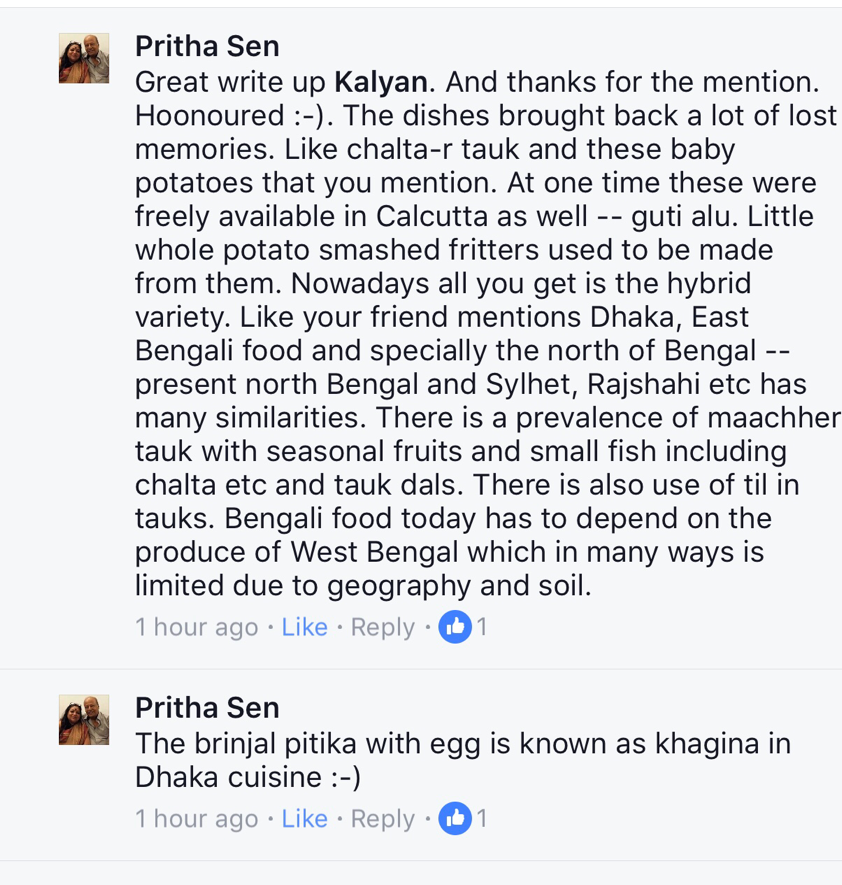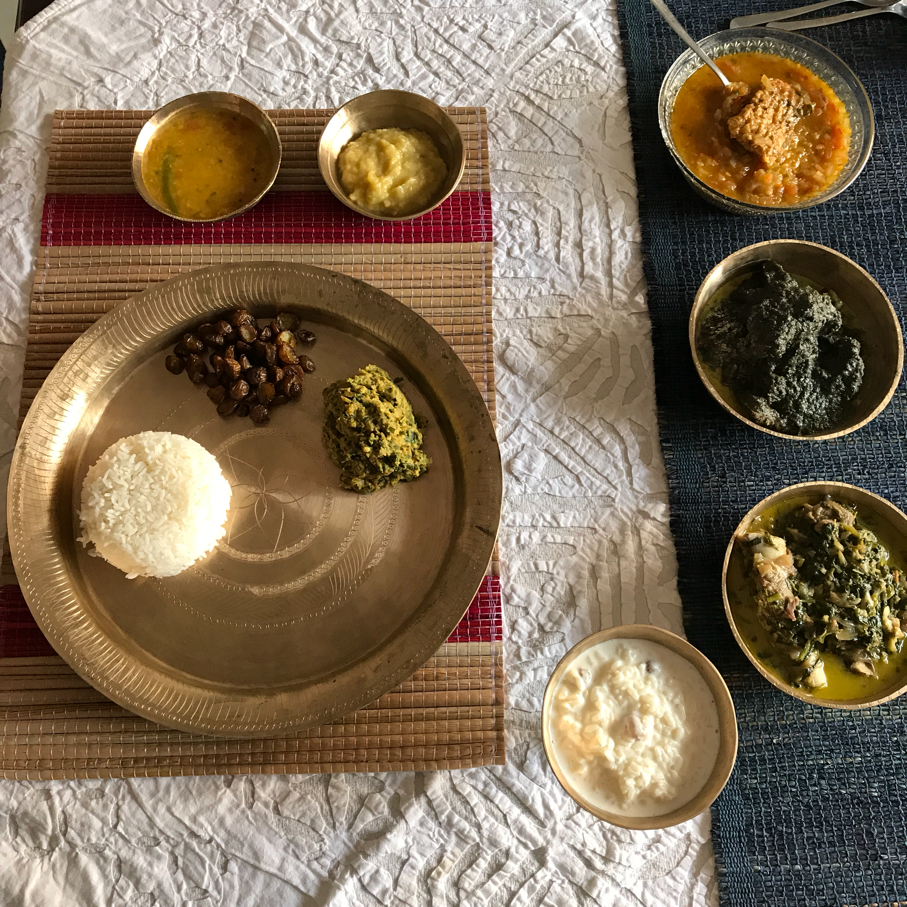
My Assamese meal from O’Tenga
The search for the ‘meal
of the year’
of the year’
I am going to tell you about one of the nicest meals that I have had so far this year in what has been a year packed with some great
meals.
meals.
Everything was perfect about this meal. The food was light
and well flavoured. Each dish was seasoned well and seemed very complete in terms of its
spicing and didn’t overwhelm or intimidate one. The ingredients used shone through in every course. What was served, was
Indian food no doubt and yet was not very familiar to me. It was not
‘exotic’ or bizarre either, and every mouthful offered the promise of comfort food. The company in which I had it was lovely too.
and well flavoured. Each dish was seasoned well and seemed very complete in terms of its
spicing and didn’t overwhelm or intimidate one. The ingredients used shone through in every course. What was served, was
Indian food no doubt and yet was not very familiar to me. It was not
‘exotic’ or bizarre either, and every mouthful offered the promise of comfort food. The company in which I had it was lovely too.
The meal made me very very happy and I have been raving
about it ever since on social media and I spoke about it on my radio chat with Annie
on Radio One FM 94.3 FM, but that’s me. If I come across something really nice,
I love to tell people about it.
about it ever since on social media and I spoke about it on my radio chat with Annie
on Radio One FM 94.3 FM, but that’s me. If I come across something really nice,
I love to tell people about it.
Just another Mumbai
immigrant story
immigrant story

With Priyangi (in black) and Joyee of O’Tenga
The meal I am talking of was an Assamese lunch. It was put
together by the folks at O’Tenga.
O’Tenga was set up by a couple of young Assamese ladies, Joyee Mahanta and
Priyangi Borthakur earlier this year.
together by the folks at O’Tenga.
O’Tenga was set up by a couple of young Assamese ladies, Joyee Mahanta and
Priyangi Borthakur earlier this year.
They had come to Mumbai as students from two different parts
of Assam in the early 2000s and didn’t know each other back then. They first met at a student’s hostel here and have remained friends since then. Mumbai is where they then later started their careers and
met their husbands too. Eventually Mumbai became home for them, just as it has
for me.
of Assam in the early 2000s and didn’t know each other back then. They first met at a student’s hostel here and have remained friends since then. Mumbai is where they then later started their careers and
met their husbands too. Eventually Mumbai became home for them, just as it has
for me.
Like me and millions of immigrants across the world, it turned out that they too began to miss their
home food in their new home. This ‘culinary home-sickness’ was the reason why I had once
taught myself to cook by calling my granny for recipes and by looking up the
internet for recipes. These dishes became a part of our kitchen repertoire and
I later taught our cook, Banu, to make these dishes too.
home food in their new home. This ‘culinary home-sickness’ was the reason why I had once
taught myself to cook by calling my granny for recipes and by looking up the
internet for recipes. These dishes became a part of our kitchen repertoire and
I later taught our cook, Banu, to make these dishes too.
Joyee and Priyangi showed more spunk and enterprise than me
though. They decided to set up an Assamese food delivery outfit which would
supply food across Mumbai. Their aim was to reach out to their fellow Assamese
immigrants for business. Turns out that a large proportion of their clientele
are non-Assamese though. I am not surprised. That’s the power of the food that they offer.
though. They decided to set up an Assamese food delivery outfit which would
supply food across Mumbai. Their aim was to reach out to their fellow Assamese
immigrants for business. Turns out that a large proportion of their clientele
are non-Assamese though. I am not surprised. That’s the power of the food that they offer.
The inception of O’Tenga
Priyangi and Joyee are not trained chefs. They had earlier
worked in media companies. While they knew the basics of cooking, they called up assorted grandmothers, mothers,
mother in laws, aunts and elder sisters across Assam for recipes when they decided to set up O’Tenga. They then
tried to replicate these in their kitchens at Mumbai, with their husbands
(Joyee’s is non – Assamese) acting as tasters. Business calls came down to
choosing between an aunt’s recipes over their mother’s recipes at times. For the sake of family harmony, I do hope that
the results were not conveyed back home.
worked in media companies. While they knew the basics of cooking, they called up assorted grandmothers, mothers,
mother in laws, aunts and elder sisters across Assam for recipes when they decided to set up O’Tenga. They then
tried to replicate these in their kitchens at Mumbai, with their husbands
(Joyee’s is non – Assamese) acting as tasters. Business calls came down to
choosing between an aunt’s recipes over their mother’s recipes at times. For the sake of family harmony, I do hope that
the results were not conveyed back home.
They currently work on the model of a day’s advance notice
for taking orders and they deliver across Mumbai with a flexible delivery
charge applied outside of Andheri.
for taking orders and they deliver across Mumbai with a flexible delivery
charge applied outside of Andheri.
Not being trained chefs, it is through trial and error that
they taught themselves how to tackle the volume, variety and consistency needs of a commercial food delivery enterprise.
they taught themselves how to tackle the volume, variety and consistency needs of a commercial food delivery enterprise.
I think that it would be really
lovely if some good hearted chef were to mentor such home chefs and help them up their games.
lovely if some good hearted chef were to mentor such home chefs and help them up their games.
The Assamese lotus
blooms in Mumbai
blooms in Mumbai
Priyangi and Joyee had got in touch with me some time back
and had offered to send some food home for me to taste. However, I was not sure
if taking food out of white sterile faceless plastic boxes at home would tell
me much about their fare. So I shamelessly invited myself over to the O’Tenga kitchen in Mumbai’s suburb of Andheri to try out the food.
and had offered to send some food home for me to taste. However, I was not sure
if taking food out of white sterile faceless plastic boxes at home would tell
me much about their fare. So I shamelessly invited myself over to the O’Tenga kitchen in Mumbai’s suburb of Andheri to try out the food.
This was not my first encounter with Assamese food though. I
was possibly the among the first customers of Gitika Saikia’s Assamese pop up meals and had
quite enjoyed that experience and have had her food many times since the. If one was to credit
someone with being the ambassador of Assamese food in Mumbai, surely that would
be Gitika. I have also eaten Assamese food at a restaurant called Axomi at
Bangalore. I can’t say that these four or five odd meals made me an ‘expert’ in
Assamese food but they definitely made me hungry to know more.
was possibly the among the first customers of Gitika Saikia’s Assamese pop up meals and had
quite enjoyed that experience and have had her food many times since the. If one was to credit
someone with being the ambassador of Assamese food in Mumbai, surely that would
be Gitika. I have also eaten Assamese food at a restaurant called Axomi at
Bangalore. I can’t say that these four or five odd meals made me an ‘expert’ in
Assamese food but they definitely made me hungry to know more.
I was glad that I went over to their pace as it was lovely meeting the young and chirpy folks behind O’Tenga, Joyee and
Priyangi, finally and they most patiently guided me through the meal that afternoon.
Priyangi, finally and they most patiently guided me through the meal that afternoon.
The food had got slightly lukewarm thanks to the many photos
that we shot and phone videos too by the time I sat down to eat but still it
all tasted pretty good. This meant that this is not the sort of food that suffers if you don’t eat it
immediately after it is cooked.
that we shot and phone videos too by the time I sat down to eat but still it
all tasted pretty good. This meant that this is not the sort of food that suffers if you don’t eat it
immediately after it is cooked.
A crash course in
Assamese food
Assamese food
I got a refresher
course on Assamese food from the girls and will try to share what I learnt from
them.
course on Assamese food from the girls and will try to share what I learnt from
them.

The lighter coloured dish is the Khar and the dal is the ou tenga masor dal
We started our meal with ‘Khar’, which has nothing to do with the suburb of the same name in
Mumbai. PJs aside, it is actually a dish which brings in an alkaline touch to
the start of the meal and quells any acidity which one might have. Given that
us Bengalis are obsessed with acidity, this piece of information caught my
interest. Khars can be of various types from what I understand. This one was an Omita Khar made with mashed unripe papaya to which the ‘khar’ was blended in. Khar is a
concoction made by filtering water through sun dried banana peels which the
girls have brought back from Assam. I mixed this khar with rice and ate it. It
did have a very fresh and vibrant taste it it and made for a nice start to the
meal.
Mumbai. PJs aside, it is actually a dish which brings in an alkaline touch to
the start of the meal and quells any acidity which one might have. Given that
us Bengalis are obsessed with acidity, this piece of information caught my
interest. Khars can be of various types from what I understand. This one was an Omita Khar made with mashed unripe papaya to which the ‘khar’ was blended in. Khar is a
concoction made by filtering water through sun dried banana peels which the
girls have brought back from Assam. I mixed this khar with rice and ate it. It
did have a very fresh and vibrant taste it it and made for a nice start to the
meal.
There were potatoes in the meal. Baby potatoes, and micro
mini ones ones at that too, which are called guti
alu and were sourced from Assam. This was lightly friedwith salt and pepper and went very well
the dal and rice.
mini ones ones at that too, which are called guti
alu and were sourced from Assam. This was lightly friedwith salt and pepper and went very well
the dal and rice.
The dal that they served is called ou tenga mosur dal, and is made with red lentils (mooshoor or
mooshuri in Bengali) and flavoured with slices of elephant apples. Joyee told me to avoid swallowing the
chunks of elephant apple as it is fibrous and can get stuck in one’s throat.
mooshuri in Bengali) and flavoured with slices of elephant apples. Joyee told me to avoid swallowing the
chunks of elephant apple as it is fibrous and can get stuck in one’s throat.
The dal was similar to the tok dal that my mother made back home in Kolkata. Tok dal is made with mooshoor dal and unripe mangoes. Tok (tauk) means sour in Bengali
as does ‘tenga’ apparently in Assamese. The Assamese version of the dal is made with elephant
apple instead of mangoes. Elephant appple is called Ou Tenga in Assamese. That’s where the name O’Tenga comes
from.
as does ‘tenga’ apparently in Assamese. The Assamese version of the dal is made with elephant
apple instead of mangoes. Elephant appple is called Ou Tenga in Assamese. That’s where the name O’Tenga comes
from.
I’d not heard of or come across elephant apples while growing up in Kolkata, but a
former market research colleague of mine, Sanjiv Sen, later told me on Facebook
that elephant apple is apparently commonly used in Kolkata too and is called chalta.
He told me that this is often found in kitchens in Dhaka as well.
former market research colleague of mine, Sanjiv Sen, later told me on Facebook
that elephant apple is apparently commonly used in Kolkata too and is called chalta.
He told me that this is often found in kitchens in Dhaka as well.
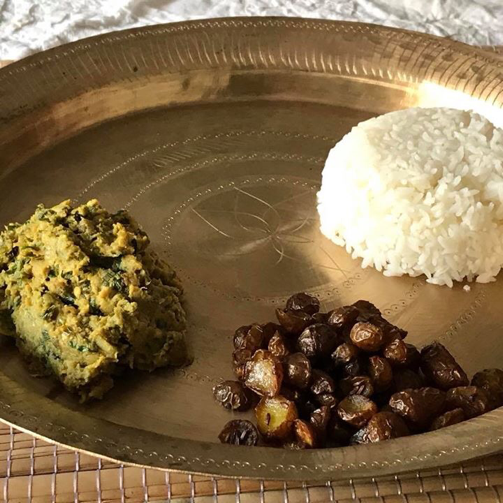
That’s the pitika and in the middle is the gutli alu
There was the famed pitika of course. The version that I have had before is the
traditional alu pitika made with mashed potato and mustard oil and chopped raw
red onions and chillies. That is similar to the Bengali alu makha which
features in alu bhaate (mashed potato) and rice.
traditional alu pitika made with mashed potato and mustard oil and chopped raw
red onions and chillies. That is similar to the Bengali alu makha which
features in alu bhaate (mashed potato) and rice.
This time I had a different
version of the pitika. This one was made with smoked aubergine mashed with egg
and it tasted brilliant. The taste was reminiscent of the Bengali begun pora
and the middle eastern baba ganoush, while the egg added a mild creaminess to
the texture. The dish is called Bengena
koni pitika on the O’Tenga menu and you should definitely try it. I had it with rice but would work well with roti or bread or pita bread too.
version of the pitika. This one was made with smoked aubergine mashed with egg
and it tasted brilliant. The taste was reminiscent of the Bengali begun pora
and the middle eastern baba ganoush, while the egg added a mild creaminess to
the texture. The dish is called Bengena
koni pitika on the O’Tenga menu and you should definitely try it. I had it with rice but would work well with roti or bread or pita bread too.
The rice
that they served was short grained rice served from Assam which is called Joha Saul.
that they served was short grained rice served from Assam which is called Joha Saul.
They had three home made Assamese pickles which I tried with the dal and rice. The black sesame and mustard oil one won my heart.
Coming to the meat of things

Mutton with herbs
No, the meal was not all vegetarian!
There was a
lovely mutton (goat) meat dish. It was cooked with a mix of three types of
greens…spinach, coriander and methi (fenugreek) leaves. In Assam, they add more greens I
was told but it seemed that those were difficult to source in Mumbai.
lovely mutton (goat) meat dish. It was cooked with a mix of three types of
greens…spinach, coriander and methi (fenugreek) leaves. In Assam, they add more greens I
was told but it seemed that those were difficult to source in Mumbai.
The
mutton was cooked like a dream and was very tender. There was a marrow bone, which by then I had been made
to feel comfortable enough to suck on without worrying about social niceties.
The sauce had a light and brothy feel to it and tasted very fresh. It reminded
me of home again. Of the spinach with mutton that my mother used to cook us on
Sundays when we were kids, till she switched to chicken thanks to the bad stuff that she heard
about red meat and its effect on the heart in the mid 80s. This dish is called Xanmehole Xaakor mutton. You can refer
to it as ‘mutton with mixed herbs’ while placing an order with O’Tenga. It had a slight
residual green chilli kick to it but nothing too intimidating.
mutton was cooked like a dream and was very tender. There was a marrow bone, which by then I had been made
to feel comfortable enough to suck on without worrying about social niceties.
The sauce had a light and brothy feel to it and tasted very fresh. It reminded
me of home again. Of the spinach with mutton that my mother used to cook us on
Sundays when we were kids, till she switched to chicken thanks to the bad stuff that she heard
about red meat and its effect on the heart in the mid 80s. This dish is called Xanmehole Xaakor mutton. You can refer
to it as ‘mutton with mixed herbs’ while placing an order with O’Tenga. It had a slight
residual green chilli kick to it but nothing too intimidating.
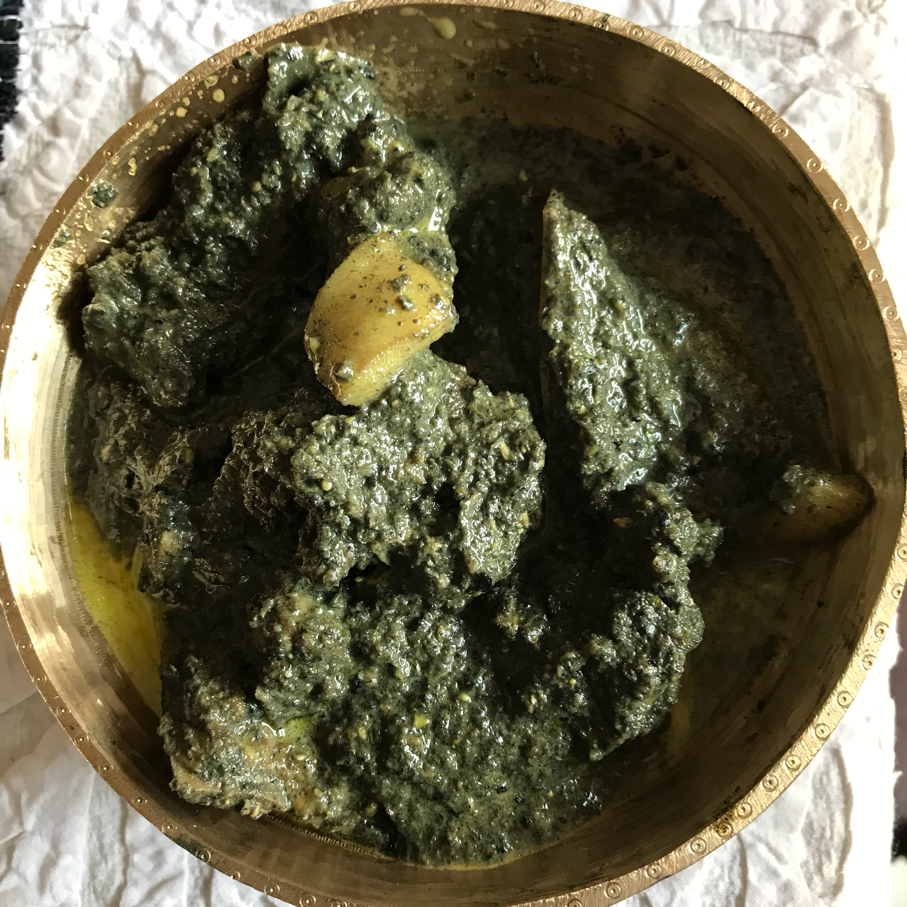
Til Diya gahori, pork with black sesame
The lunch featured an amazing pork dish cooked in a black til (sesame)
paste. This was the til diya gahori. There
were pieces of pork belly too with just the right balance of fat. Priyangi was amused to see me zero in on the pieces of fat. Apparently the right proportion of fat to meat has been a tough one to crack. They have come across some customers who do not
want fat and some like me who do. Still want to run a food business?
paste. This was the til diya gahori. There
were pieces of pork belly too with just the right balance of fat. Priyangi was amused to see me zero in on the pieces of fat. Apparently the right proportion of fat to meat has been a tough one to crack. They have come across some customers who do not
want fat and some like me who do. Still want to run a food business?
The til (sesame) added an intriguing and yet very reassuring woody/
nutty taste to the curry. There was hardly any other spices used apart in the dish apart from the odd touch of turmeric powder I was told.
nutty taste to the curry. There was hardly any other spices used apart in the dish apart from the odd touch of turmeric powder I was told.
The dish brought back memories of the
delicious Khasi black sesame pork that Pritha Sen had cooked for me at Gurugram
recently. If I was to compare the quality of the pork at O’Tenga with the excellent ‘Naga pork’ that Chitralekha, an Assamese lady who is an advertising professional (still), had cooked for us at a party recently, I
would say that Chitra’s pork was cooked a lot more tender thanks to the 4 hours
of slow cooking that went it and was possibly one of the best renditions of pork
cooking that I have had in Mumbai. Hers had fermented bamboo shoot though
which, as I said earlier, is something I am yet to make peace with. As I had
told them about my uneasy relationship with fermented bamboo shoot (I don’t
like the odour) earlier on the phone, they had kept it away from my lunch at O’Tenga. Priyangi
told me with a smile that her mother doesn’t like fermented bamboo shoot either even though she is Assamese.
delicious Khasi black sesame pork that Pritha Sen had cooked for me at Gurugram
recently. If I was to compare the quality of the pork at O’Tenga with the excellent ‘Naga pork’ that Chitralekha, an Assamese lady who is an advertising professional (still), had cooked for us at a party recently, I
would say that Chitra’s pork was cooked a lot more tender thanks to the 4 hours
of slow cooking that went it and was possibly one of the best renditions of pork
cooking that I have had in Mumbai. Hers had fermented bamboo shoot though
which, as I said earlier, is something I am yet to make peace with. As I had
told them about my uneasy relationship with fermented bamboo shoot (I don’t
like the odour) earlier on the phone, they had kept it away from my lunch at O’Tenga. Priyangi
told me with a smile that her mother doesn’t like fermented bamboo shoot either even though she is Assamese.

Masor tenga with peti piece of rohu
There was a strange twist to the meal plot which I must tell you about. There was a rohu fish curry and the girls wanted me to have it at the end of the meal but I have an ideological problem with that.
The dish in question was the iconic Assamese dish, masor tenga, or, in this case lau
bilahi masor tenga as it was made with bottle gourd and tomato. Masor tenga is
the name of the sour fish curry that is possibly the most famous Assamese dish.
Tenga, as I said earlier, means sour. Joyee and Priyangi told me that the
Assamese like to end their meal with a touch of sour, which in this meal was the
fish curry.
bilahi masor tenga as it was made with bottle gourd and tomato. Masor tenga is
the name of the sour fish curry that is possibly the most famous Assamese dish.
Tenga, as I said earlier, means sour. Joyee and Priyangi told me that the
Assamese like to end their meal with a touch of sour, which in this meal was the
fish curry.
Now the problem is that we Bengalis eat fish before meat in
a meal and I couldn’t think of eating the mosur tenga at the end. A meal has to end with meat after all. Meat
before fish would bring my whole existence into question and we couldn’t have
that could we?
a meal and I couldn’t think of eating the mosur tenga at the end. A meal has to end with meat after all. Meat
before fish would bring my whole existence into question and we couldn’t have
that could we?
So I had the masor tenga before I ate the pork and the mutton and
then later, to make the girls happy, had a bit of the tenga gravy with rice at
the end. The gravy reminded me of a light rasam as well as Bengali machher
jhols when people add tomato to them. It was tangy but not uncomfortably so.
It combined well with rice and this finale reminded me of South Indians who
like to finish their meals with a bit of curd rice.
then later, to make the girls happy, had a bit of the tenga gravy with rice at
the end. The gravy reminded me of a light rasam as well as Bengali machher
jhols when people add tomato to them. It was tangy but not uncomfortably so.
It combined well with rice and this finale reminded me of South Indians who
like to finish their meals with a bit of curd rice.
Sweet endings
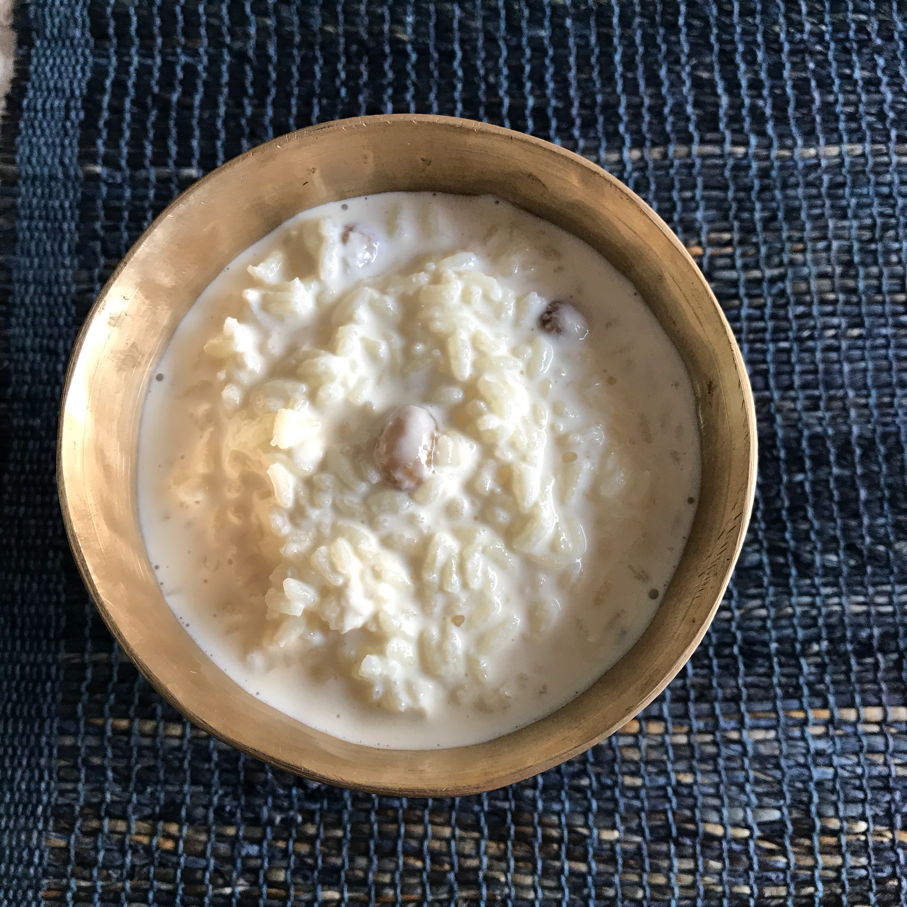
Payokh
For dessert there was payokh or what in Bengal we know as
payesh. It was full of kishmish (raisin), which I love, and which my grandmother
makes a point to add for me. They have a ‘secret ingredient’ at O’Tenga which
the girls asked me to identify on camera and, I did. It was komphur or camphor!
It brought back childhood memories of Lakshmi pujo Prasad of shinni that my
granny used to make. I can handle its intense taste only in small measures though to be
honest.
payesh. It was full of kishmish (raisin), which I love, and which my grandmother
makes a point to add for me. They have a ‘secret ingredient’ at O’Tenga which
the girls asked me to identify on camera and, I did. It was komphur or camphor!
It brought back childhood memories of Lakshmi pujo Prasad of shinni that my
granny used to make. I can handle its intense taste only in small measures though to be
honest.
Priyangi and Joyee told me that there is a huge variety to
Assamese food and there are variations between what people eat in the plains
and in the hills and across tribes and that this is often a function of the
locally available produce. Their food at O’Tenga, Joyee and Priyangi tells me, represents a
cross-culture of what Assamese food stands. The food that they serve here is a function of
ingredients that they can access from home and ingredients that are available in Mumbai
which means that the food might not have the very same taste that you can expect to
find in Assam. They told me that the tastes or even the cooking times of vegetables one gets here might vary from that of their equivalents in Assam.
Assamese food and there are variations between what people eat in the plains
and in the hills and across tribes and that this is often a function of the
locally available produce. Their food at O’Tenga, Joyee and Priyangi tells me, represents a
cross-culture of what Assamese food stands. The food that they serve here is a function of
ingredients that they can access from home and ingredients that are available in Mumbai
which means that the food might not have the very same taste that you can expect to
find in Assam. They told me that the tastes or even the cooking times of vegetables one gets here might vary from that of their equivalents in Assam.
Joyee and Priyangi also told me that they have tried to make sure that the
food in their regular menu doesn’t taste too alien or extreme as that might turn off
those who are seeking comfort food at home. Their aim is to make their native Assmese food part of the mainstream here. For example, knowing that I can’t
handle extreme spices, they avoided giving me dishes that has bhoot jholakia,
the super spicy chilli from North Eastern India.
food in their regular menu doesn’t taste too alien or extreme as that might turn off
those who are seeking comfort food at home. Their aim is to make their native Assmese food part of the mainstream here. For example, knowing that I can’t
handle extreme spices, they avoided giving me dishes that has bhoot jholakia,
the super spicy chilli from North Eastern India.
Home cooked happiness
At the end, bring back your attention I want to the mosur tenga or the fish curry that I ate, to make a point to you.
The
girls had apparently gone through my blog and seen that I like the peti (fatty belly)
piece of rohu and had kept that for me in the fish that they served. They told
me that while taking orders on the phone, they try to understand what the
customer likes and work the food around that. This to me was an example of
that.
girls had apparently gone through my blog and seen that I like the peti (fatty belly)
piece of rohu and had kept that for me in the fish that they served. They told
me that while taking orders on the phone, they try to understand what the
customer likes and work the food around that. This to me was an example of
that.
The other thing that I liked was they had not excessively
fried the fish before putting it into the curry. The fish was shallow fried instead,
just as I do at home. This has been my biggest grouse against Bengali
restaurants in Mumbai. The fact that they fry the fish to oblivion before
adding it to curries. The fish in the O’Tenga curry felt much closer to home that
the fish curries that I order from Bengali restaurants here, and that to me captured the beauty of the meal that I had.
fried the fish before putting it into the curry. The fish was shallow fried instead,
just as I do at home. This has been my biggest grouse against Bengali
restaurants in Mumbai. The fact that they fry the fish to oblivion before
adding it to curries. The fish in the O’Tenga curry felt much closer to home that
the fish curries that I order from Bengali restaurants here, and that to me captured the beauty of the meal that I had.
The fact that it was food from a culture different from mine
and yet spelt of the comfort and love that home food stands for at its best. I guess the fact that this food is from the East of India possibly made
it touch my heart that much more than food from the Southern or Western coasts of India
would.
and yet spelt of the comfort and love that home food stands for at its best. I guess the fact that this food is from the East of India possibly made
it touch my heart that much more than food from the Southern or Western coasts of India
would.
Phrases such as ‘food cooked from the heart and with love’
and ‘ food cooked with honesty and integrity’ can often turn out to be
meaningless clichés unless the food delivers what it promises to do and when it does,
as it did at the O’Tenga lunch for me, then it can make one very happy.
and ‘ food cooked with honesty and integrity’ can often turn out to be
meaningless clichés unless the food delivers what it promises to do and when it does,
as it did at the O’Tenga lunch for me, then it can make one very happy.
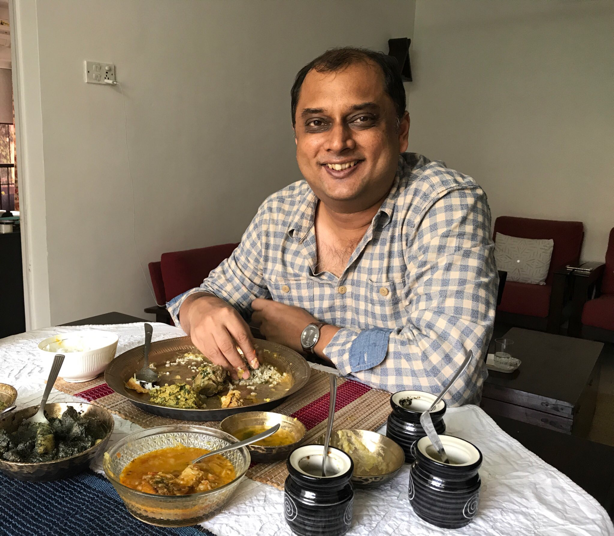
The smile says it all
Do check out this iPhone video that I shot with Joyee and Priyangi with their assistant cook most kindly doubling up as the DOP too:
Notes:
The meal was hosted by
O’Tenga and this is not an anonymous review.
O’Tenga and this is not an anonymous review.
While I had gone to have this meal, O’Tenga works an a delivery
model and this is how it operates in their words:
model and this is how it operates in their words:
To
order, call on 9619518938 or 9833962210.
order, call on 9619518938 or 9833962210.
We
take orders between 10 AM and 10 PM. People need to place their
orders at least 24 hours in advance.
take orders between 10 AM and 10 PM. People need to place their
orders at least 24 hours in advance.
Free
home-delivery for all orders from Andheri West above Rs. 500/-
home-delivery for all orders from Andheri West above Rs. 500/-
We
deliver to the rest of the city as well with an additional delivery charge of
Rs. 200 on weekdays and Rs. 250 on weekends and public holidays.
deliver to the rest of the city as well with an additional delivery charge of
Rs. 200 on weekdays and Rs. 250 on weekends and public holidays.
You might find this of
interest too:
interest too:
1. My
first taste of Assamese food at Gitika Sakia’s pop up meal
first taste of Assamese food at Gitika Sakia’s pop up meal
2. Axomi,
an Assamese restaurant at Bangalore.
an Assamese restaurant at Bangalore.
3. An
Assamese winter feast at Gitika’s
Assamese winter feast at Gitika’s
Update: After I posted this article, Pritha Sen added to the discussion which followed and her comments helped give a context to the links which I had intuitively between Assamese food and my native Bengali food which is from the Bangal or erstwhile East Indian side. I thought I’ll add her comment here for the understanding of those who read this post:
Pritha Sen: The dishes brought back a lot of lost memories. Like chalta-r tauk and these baby potatoes that you mention. At one time these were freely available in Calcutta as well — guti alu. Little whole potato smashed fritters used to be made from them. Nowadays all you get is the hybrid variety. Like your friend mentions Dhaka, East Bengali food and specially the north of Bengal — present north Bengal and Sylhet, Rajshahi etc has many similarities. There is a prevalence of maachher tauk with seasonal fruits and small fish including chalta etc and tauk dals. There is also use of til in tauks. Bengali food today has to depend on the produce of West Bengal which in many ways is limited due to geography and soil.
